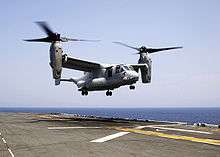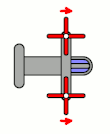Transverse rotors
Transverse rotor rotorcraft, also known as a bicopter, is a twin-rotor helicopter with two large rotor assemblies mounted side-to-side, usually directly lateral to the aircraft's center of mass.


Single-rotor helicopters (unicopters) need an additional tail rotor or tail exhaust to neutralize the reactional angular momentum produced by the main rotor. Transverse rotor helicopters, however, use counter-rotating rotors, with each cancelling out the other's torque. Counter-rotating rotor blades also won't collide with and destroy each other if they flex into the other rotor's pathway. In addition, transverse rotor configuration has the advantage of higher payload with shorter blades, since there are two sets working to provide lift. Also, all of the power from the engines can be used for lift, whereas a single-rotor helicopter must divert part of its engine power to generate tail thrust.
Transverse rotor design with rotatable nacelles are known as tiltrotors while designs where the whole wing rotates are known as tiltwings.
List of transverse rotor rotorcraft
Transverse-mounted helicopters
- Bratukhin B-11 (1948)
- Bratukhin G-3 (1946)
- Cierva W.5 (1938)
- Cierva W.11 Air Horse (1948)
- Firth Helicopter (1952)
- Focke-Achgelis Fa 223 (1941)
- Focke-Wulf Fw 61 (1936)
- Kamov Ka-22 (1959)
- Kamov V-100 (1980s)
- Landgraf H-2 (1944)
- McDonnell XHJH Whirlaway (1946)
- Mil Mi-12 (1967)
- Platt-LePage XR-1 (1941)
Transverse-mounted tiltrotors
See also
| Wikimedia Commons has media related to Transverse-rotor helicopters. |